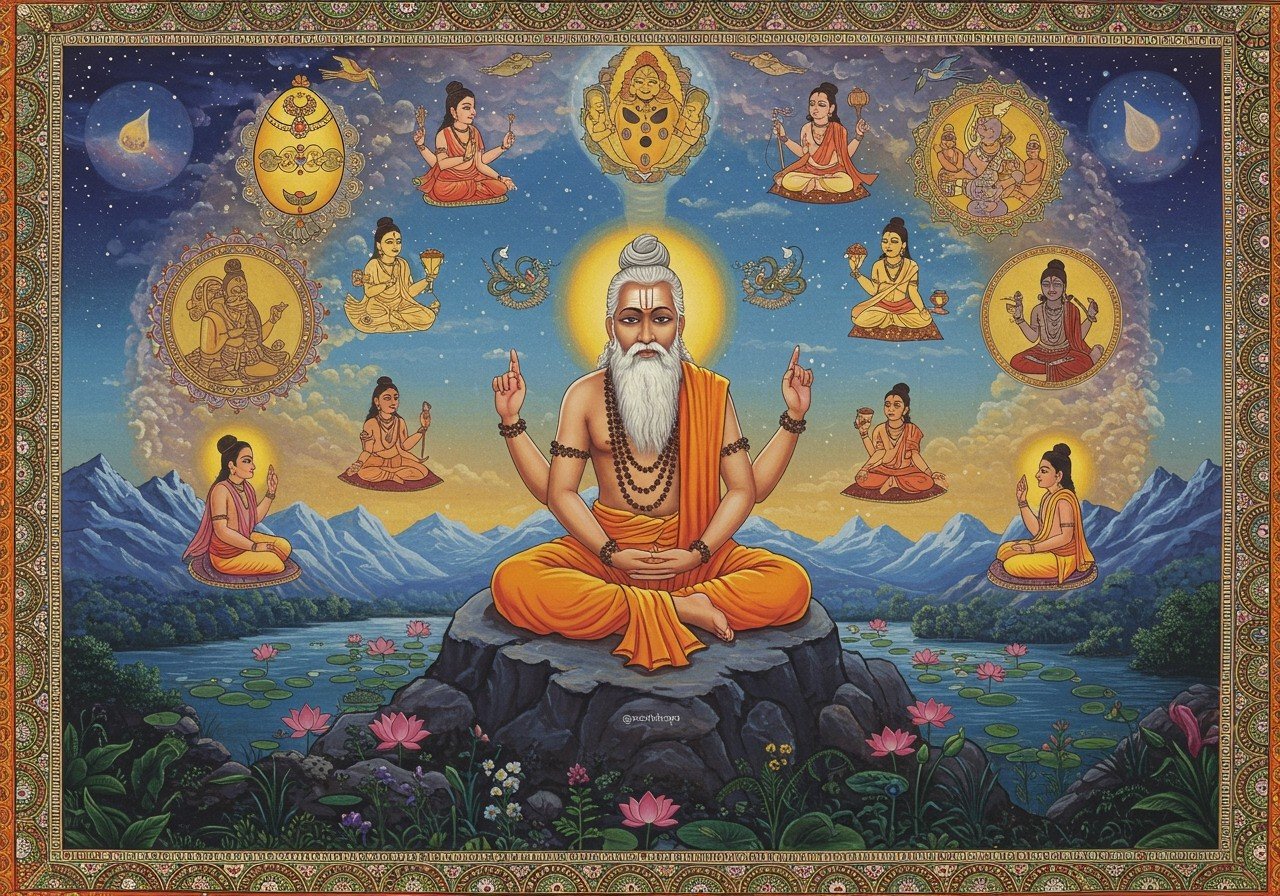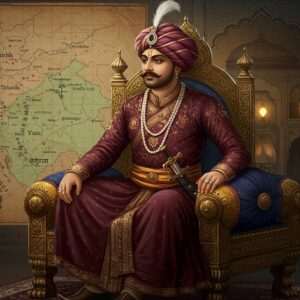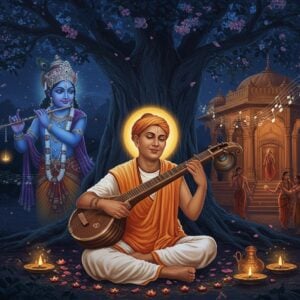
Kashyapa holds a significant place in Indian mythology and history. Revered as both a mythological sage and a historical figure, his narrative has profoundly influenced religion and culture in India. This exploration delves into the historical and mythological aspects of Kashyapa, examining how his story has shaped traditions.
Historical Context of Kashyapa
Ancient Indian texts, including the Vedas and Puranas, mention Kashyapa. He is considered a key progenitor in Hindu mythology, linked to numerous gods, demons, and creatures. Kashyapa’s role in creation myths and his lineage are crucial for understanding dynastic histories. Archaeological findings and ancient texts provide glimpses into his historical presence. He is credited with composing hymns, primarily found in Mandala IX of the Rigveda, often dedicated to Soma Pavamana. The Brihadaranyaka Upanishad also mentions him, further solidifying his presence in Vedic literature.
Mythological Depiction of Kashyapa
Kashyapa, a revered sage in ancient Indian scriptures, stands among the seven great sages known as the Saptarishis, highly respected figures in Hindu tradition. His story unfolds within the vast tapestry of mythology, revealing his role as the progenitor of both divine and demonic entities.
- Progenitor of Gods and Demons: Kashyapa’s marriages, particularly to Aditi and Diti, embody the balance of cosmic forces. Aditi’s children, the Adityas, represent light and virtue, while Diti’s offspring, the Daityas, symbolize darkness and challenge. This duality is essential for maintaining cosmic harmony.
Through his various wives, daughters of Daksha Prajapati, Kashyapa fathered a diverse range of beings, including Adityas, Rudras, Vasus, Daityas, Nagas, and more. All living beings are believed to have descended from his progeny.
- Symbolism of Progeny: The symbolism within Kashyapa’s offspring is profound and multifaceted. The Adityas, including Surya, the sun god, embody strength and vitality. The Daityas, on the other hand, challenge the gods, creating narratives of conflict and resolution central to Hindu mythology.
The Nagas, serpent beings of significant cultural and religious symbolism, also descend from Kashyapa. They represent fertility, protection, and the cyclical nature of life and death.
- Kashyapa and Kashmir: Legends attribute the draining of the Kashmir valley, making it habitable, to Kashyapa. It is believed that the name “Kashmir” itself is derived from his name. Another legend states that the earth is referred to as Kashyapi due to Parashurama’s request for Kashyapa to proceed to Mahendra Parvat.
Kashyapa Buddha vs. Gautama Buddha
Buddhist tradition distinguishes between Kashyapa Buddha and Gautama Buddha. Kashyapa Buddha is regarded as a predecessor to Gautama Buddha, the historical founder of Buddhism. The concept of multiple Buddhas is integral to Buddhist cosmology, reflecting the eternal cycle of enlightenment. Kashyapa Buddha’s narratives exist alongside Gautama’s teachings, providing a rich tapestry of historical and philosophical contexts. Recognizing this distinction deepens the appreciation for Buddhist teachings and their evolution.
Kashyapa’s Various Names
Kashyapa is known by several names, each reflecting his diverse roles. Names like Kasyapa, Kachchhapa (tortoise, symbolizing patience and endurance), and Marichi (ray of light, symbolizing enlightenment) appear in different traditions, emphasizing his varied aspects as a sage, creator, and ancestor. The significance of each name is understood within the specific context of the stories and texts in which they are found.
Kashyapa’s Influence on Rituals and Culture
Kashyapa’s influence extends to contemporary Hindu rituals. His lineage is particularly significant in Vedic rituals, with his name invoked in mantras and hymns, demonstrating the reverence for his enduring legacy. In regions traditionally associated with Kashyapa, like Kashmir and the Deccan Plateau, his mythology intertwines with local lore, enriching their cultural fabric and showcasing his impact on traditions and rituals.
Find Authentic Ritual Items for Kashyapa Worship at Poojn.in
Poojn.in, India’s leading online store for cultural and religious goods, offers a wide selection of authentic items for Kashyapa-related rituals and worship. Explore our collection of traditional puja items, including:
- Pure copper and brass vessels for offerings
- Traditional dhoop and incense holders
- Specially crafted puja thalis
- Sacred thread (janeu)
- Pure cotton wicks
- Copper water pots (kalash)
All our products are quality-assured, verified by Pandits, and come with proper packaging to ensure ritual purity. We offer convenient online shopping with doorstep delivery across India. Visit poojn.in today or contact us at +91 3369029784 for bulk orders and special requirements. We are committed to providing genuine ritual items that honor the sacred traditions of Kashyapa worship.
Adiyogi Marble Dust Murti
Lord Shiva Marble Dust Murti
Conclusion
Kashyapa’s legacy is a blend of myth and history, deeply woven into Indian tradition. His narratives, rich with symbolism, offer insights into cosmic balance, enlightenment, and cultural heritage. His influence spans both Hindu and Buddhist traditions. Understanding Kashyapa allows us to connect with a part of history that continues to shape rituals, stories, and beliefs. His story is not merely a relic of the past but a living part of our spiritual and cultural journey.
Frequently Asked Questions about Kashyapa
Who was Kashyapa in Hindu mythology? Kashyapa is a revered Vedic sage, one of the Saptarishis, and the progenitor of gods, demons, and humans.
Kashyapa is particularly associated with the Rigveda, where he contributed hymns often focused on Soma Pavamana. This places him within a specific historical and ritualistic context.
What distinguishes Kashyapa Buddha from Gautama Buddha? Kashyapa Buddha is a past Buddha in Buddhist tradition, while Gautama Buddha is the historical founder of Buddhism. Both figures hold important places within the broader Buddhist cosmology.
Are there other names for Kashyapa? Yes, Kashyapa is also known as Prajapati, highlighting his role as a creator and progenitor. Additionally, variations like Kasyapa and Kachchhapa exist.
Is Kashyapa a historical figure or a mythological one? Kashyapa’s origins lie within the Vedic period, where he is mentioned as a Rishi and hymn composer. While his historical existence is debated, his role in mythology is prominent and influential.
What is Kashyapa’s significance in Hindu rituals? Kashyapa is invoked in Hindu rituals, particularly those related to lineage and ancestral reverence. His presence in Vedic texts further connects him to ancient ritual practices.
Why is Kashyapa important to Hindu culture? Kashyapa’s importance lies in his role as a progenitor, a symbol of wisdom, and a link to both divine and demonic forces. He embodies the complex interplay of creation and cosmic balance within Hindu thought.
What are some myths about Kashyapa? Myths surrounding Kashyapa include his creation of various creatures and his marriages to Daksha’s daughters, each with specific cosmic roles. These myths often carry allegorical meanings related to natural phenomena and societal structures.
How do myths about Kashyapa differ from reality? Myths about Kashyapa present a symbolic and narrative understanding of the cosmos and creation. While historical evidence for his life is limited, his influence on mythology and cultural beliefs is significant. The Kashyap Samhita, an Ayurvedic treatise, provides tangible evidence of a historical figure whose teachings influenced medical practices relating to pediatrics, gynecology, and obstetrics.


